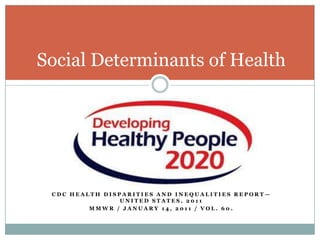
Social Determinants of Health
- 1. Social Determinants of Health CDC HEALTH DISPARITIES AND INEQUALITIES REPORT— UNITED STATES, 2011 MMWR / JANUARY 14, 2011 / VOL. 60.
- 2. Health Disparities differences in health outcomes between groups that reflect social inequalities
- 3. Finding Education and Income Those who live and work in low s socioeconomic circumstances are at an increased risk Social Mortality Determinants Morbidity of Health Unhealthy behaviors Reduced access to healthcare Inadequate quality of care A substantial proportion of the adult population with insufficient resources is vulnerable to health problems.
- 6. Finding Inadequate and unhealthy housing s Lack of structural and safety features increase risk of Injuries Blood lead levels Worsening of other Environmental conditions Hazards Poor indoor air quality increases risk of Cancer Asthma Coronary Heart disease
- 7. Air Pollution Urban counties are generally near sources of air pollution Racial and ethnic minority groups, are more likely to live in urban counties and more likely to experience a disparately larger impact
- 8. Findin Health Insurance Coverage gs Insurance coverage is strongly related to better health outcomes Healthcare Higher percentage of males are Access uninsured 18-34 year olds are twice as likely to be uninsured as 45-64 year olds Hispanics and blacks had significantly higher uninsured rates compared to non- Hispanic whites and Asian/Pacific Islanders
- 9. Findin gs Access to Preventive Influenza vaccination coverage Health Services During the 2009-2010 flu vaccination period, non-Hispanic blacks and Hispanics had lower vaccination rates than non-Hispanic whites
- 10. Preventive Screenings Colorectal cancer screenings Disparities exist based on Age group Ethnic group Disability Insurance status
- 11. Mortality
- 12. Findin gs Mortality Infant Deaths Motor Vehicle Related Deaths Health Suicides Outcomes Drug-Induced Deaths Coronary Heart Disease and Strokes Homicides
- 13. Infant Mortality African-American Infants Are 1 ½ to 3 times more likely to die than infants of other ethnicities
- 14. Suicide and Homicide Suicide Homicide Men of all ages and Highest rate for those race/ethnicities are between ages 15-34 approximately four 4 times greater in times more likely to males than females die by suicide than Highest rate among females non-Hispanic blacks
- 15. Coronary Heart Disease and Stroke Leading cause of disability African American Men and and death in US Women Men are more likely to More likely to die of die from coronary heart disease and heart diseases than stroke than their white women counterparts
- 16. Drug Induced Deaths Rates of drug-induced Prescription drug abuse deaths increased now kills more persons between 2003 and 2007 than illicit drugs among men and women of all race/ethnicities, with the exception of Hispanics. Rates are highest among non-Hispanic whites.
- 17. Morbidity
- 18. Findin Morbidity gs Obesity Pre-term Births Potentially Preventable Hospitalizations Current Asthma Prevalence Health HIV Infection Outcomes Diabetes P Hypertension and Hypertension Control
- 19. Obesity What percentage of your state’s population is obese? Prevalence of obesity is lower among whites than among blacks and Mexican-Americans Among females, prevalence of obesity is highest among blacks
- 20. Hypertension Do You Know Your Numbers? Hypertension is most prevalent among non- Hispanic blacks (42% versus 28.8% among whites). Women are significantly more likely to have hypertension controlled than men Uninsured persons are only about half as likely to have hypertension under control than those with insurance, regardless of type
- 22. Findin gs Behavioral Risk Factors Binge Drinking Adolescent Pregnancy and Childbirth Health Cigarette Smoking Outcomes
- 23. Binge Drinking What is binge drinking? Who’s at risk? Younger people and men are more likely to binge drink and consume more alcohol than older people and women. More than half of alcohol Consuming four or more consumption by adults in alcoholic drinks on one or the United States is in the more occasion for women form of binge drinking and five or more for men.
- 24. Tobacco Use Leading cause of preventable illness and death Disparities in smoking rates persist among certain racial and ethnic minorities: American Indians and Alaska Natives Smoking rates decline with increasing income Smoking rates decline with increasing educational attainment
- 25. Teen Pregnancy Disparities Persist Rates of adolescent pregnancy and childbirth have been falling or holding steady for all racial/ethnic minorities in all age groups. Birth rates for Hispanics and non-Hispanic blacks are 3 and 2.5 times those of whites
Editor's Notes
- R
